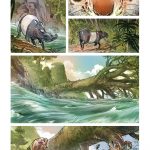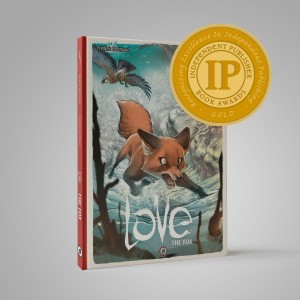Frederic and Federico, you have worked together on many books now, all of them featuring wild animals in their natural environment. What brings you back to nature so often?
Frédéric: Yes, we have been working together for almost 10 years but we haven’t done only animal stories. We published others, such as the adaptation of a very famous French novel “Rocambole”, a humorous comic on tennis, and other books.
Federico: I remember, during a comics festival in Belgium, that I was scribble-drawing an elephant to relax. I have always enjoyed drawing animals, and quite naturally, I transform them into real characters. Frederic saw me drawing this elephant pooping, a really stupid thing to draw, and he had this idea of a comic narrating nature. A few years later, he asked me to draw Love. We both really enjoy working with animals. The first drawings by prehistoric men were animals, we only follow that tradition with modern means.
Your stories are almost encyclopedic in their facts and accuracy to nature, and can even be considered educational. Is this your intention, to teach something to the reader?
Federico: I think our readers are nature lovers, so they most probably know a lot about animals and must have seen a lot of documentaries, so we have never had the pretension of teaching anything.
However, we know how to tell a story. Our story does not follow a traditional plot, and does not have a moral, but allows each reader to draw his own conclusions according to his sensibility. The panels are very precise and full of details, that’s true but, if you look carefully, behind the apparent realism, there is a lot of fiction. As an artist, I have used vegetation and trees to bring depth to the frame, I have slightly changed the proportion and the tiger’s fur for a better and easier recitation.
We did not have a proper educational scope for Love, but children play a large part of our audience so we tried to think of what we could bring to them. We decided then to create another series, a little bit more didactic, with a format and style that can also attract adults: “Little Stories”. This series is published in France and we hope to publish it also in the States.
Frederic, tell us about your career as a writer – how did you start, and what stories interest you the most?
Frédéric: I grew up on a farm in the west of France. My youth looked like a John Wayne film, on horseback. I think my love for animals comes from there. I love animals, but I am also used to seeing them live and die.
I read all the classic French-Belgian comics: Asterix, Lucky Luke, Tintin, and Mickey Mouse. Then I discovered Moebius, Tardi, Alexis, Bernet, and Hugo Pratt at the library. It was a revelation. Everything comes from there, I guess. I wanted to write stories and comics came naturally.
Later, I joined the CNBDI, the Center National of Bande Desinnée and Image, in Angoulême for two years. I met numerous students there from the Beaux-Arts and I started working on my first serious projects. Today, I collaborate with most of them: Artoupan, Mathieu Reynès, Bruno Duhamel, and Jean-Emmanuel Vermot-Desroches. My first publications often had off-the-wall humor and a non-linear structure. Obviously, only a few readers appreciated that, but they are very good memories. Daffodil, a three-book series, translated and published by Marvel US, was created during that period.
Since then, I divide my time between the Isle of Noirrmouter in France and Italy. With the distance, I am not up-to-date with the latest releases and I have stopped developing stories that follow the trends, conditioned by topics and formats wanted by the publishers.
The Love series is the fruit of all that. I really thought no editor would sign this project and I was kind of looking forward to selling Federico’s artwork in shops and creating some sort of a laboratory. Finally, JD Morvan, editor at Ankama immediately signed the project and we realized The Tiger, also thanks to his good advice.
I also write different kinds of stories as I don’t want to stick to one genre. I used other pen names: Labrémure and Lili Mésange. The genre of my stories is often determined by the artist’s graphical style. To a certain extent, I adapt, without any trouble, because of my diverse inspiration and interests. I admire authors who specialize in one genre but personally, I would get bored fast.
Despite this desire to always experiment, I have to admit that I particularly like animal stories. An animal’s movement can be read differently and we can play with that. With Federico, we have always enjoyed amusing and absurd situations, and all of our series so far have been humorous, in one way or another. Even Little Stories, our new series about animals, is dedicated to a young audience who wants to learn with fun. And animals are great for that. A chick staring at you can remind you of Inspector Clouseau… I love Peter Sellers.
Love is fiction, but its documentary format makes our work similar to a film documentary. Everything is written, but during the editing, many scenes are cut, and some are added for a perfect rhythm. I really enjoy writing about real animals also because you never know how the story will end. It is something people have often told me: “we never know how the story will finish” or “we don’t even know if the main character will survive.” It is the same thing with Love. We don’t know if the tiger will survive, but we accept that idea.
Talking about documentaries, I am really interested in that field. So little is known of nature and it is so vast that the reality of it is often more spectacular than fiction. And following Love: The Tiger, a report was broadcast focusing on the tiger and its cohabitation with humans and the reduction of its natural habitat.
Federico, your artwork is so beautiful, mixing a realistic style with an animated personality. What inspires your style? And how did you start to develop this style for yourself?
Federico: Most probably, many factors have influenced the way I draw, halfway between Disney animation and realism. First of all maybe, my love for Carl Barks comics: his ducks were in perfect Disney style and extremely dynamic but in a real environment. They did not have over-the-top distortion and their expressions were always truthful, and natural. His characters had such a concreteness that they could have been real. I have certainly been influenced by Barks, but also by the beautiful Disney cartoons and my academic formation. When I started working with Frederic, I was already working for Disney Italia, and our first book together, “Richard Lionheart,” really reflects that style: I realized anthropomorphic characters using a pencil, without inking, so as to give it a fresh look. The result vaguely recalls Robin Hood, the Disney film. We then did another project, “Rocambole,” where I distanced myself even more from the clean style, using the pencil more freely, leaving the construction lines visible, etc. At the same time, I developed a coloring technique in Photoshop that simulates a fresh and manual execution. I used the same technique for Love. In the end, I have developed a graphic style that lets me be free to express myself.
How do you both work together when creating a book? Do you share ideas at the same time, or do you take turns, exchanging your ideas after the other does their part?
Federico: On a common book, we really work hand in hand, particularly in the beginning, during the brainstorming period. We talk a lot, often joking or talking nonsense but then, we manage to lay out the story and identify what we want in terms of graphics. I then create two or three boards with characters and more complex drawings that illustrate best what I have in mind. Based on these and his own ideas, Frederic writes two or three complete pages that I illustrate. We then review it, do the necessary changes, and when we both like the result, we go to an editor. Once the book is signed, we start working on the whole project, continuously looking for a new idea and introducing changes, which makes the whole process quite challenging.
What other natural environments and wildlife would you like to explore in future volumes of the LOVE series?
Frédéric: We faced the jungle with The Tiger, a northern island covered in snow with The Fox, and the hot savannah with The Lion. For the next Love, we are going back in time: around 100 million years with the Dinosaurs! We will need to be more technical this time, even if we will be able to base our story on the scientific theories we like most. The T-Rex for example – does it have feathers or not? Some say yes, others disagree — was it a ferocious predator or a scavenger? There are many theories and we will choose the ones that make us dream and have fun, hoping that it will be the same for our readers.
Love: The Tiger is available now in the Magnetic Press store.















